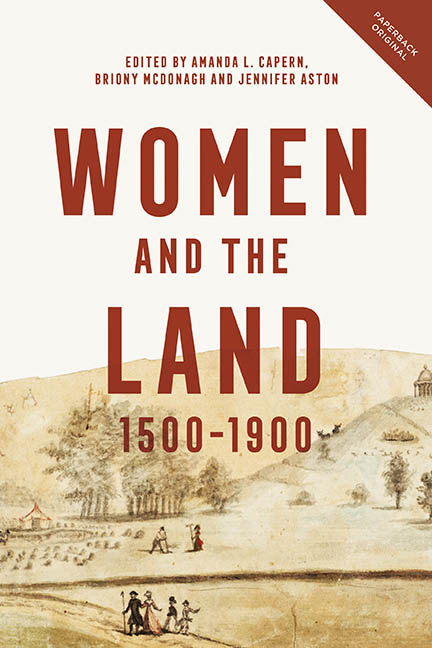Book contents
- Frontmatter
- Contents
- List of Illustrations
- List of Contributors
- Introduction: Women, Property and Land
- 1 Women, Work and Land: The Spatial Dynamics of Gender Relations in Early Modern England 1550–1750
- 2 Spinsters with Land in Early Modern England: Inheritance, Possession and Use
- 3 Becoming Anne Clifford
- 4 The Heiress Reconsidered: Contexts for Understanding the Abduction of Arabella Alleyn
- 5 From Magnificent Houses to Disagreeable Country: Lady Sophia Newdigate's Tour of Southern England and Derbyshire, 1748
- 6 On Being ‘fully and completely mistress of the whole business’: Gender, Land and Estate Accounting in Georgian England
- 7 Negotiating Men: Elizabeth Montagu, ‘Capability’ Brown and the Construction of Pastoral
- 8 Women's Involvement in Property in the North Riding of Yorkshire in the Eighteenth and Nineteenth Centuries
- 9 Invisible Women: Small-scale Landed Proprietors in Nineteenth-century England
- 10 More than Just a Caretaker: Women's Role in the Intergenerational Transfer of Real and Personal Property in Nineteenth-century Urban England, 1840–1900
- Afterword
- Select Bibliography
- Index
- PEOPLE, MARKETS, GOODS: ECONOMIES AND SOCIETIES IN HISTORY
5 - From Magnificent Houses to Disagreeable Country: Lady Sophia Newdigate's Tour of Southern England and Derbyshire, 1748
Published online by Cambridge University Press: 21 March 2020
- Frontmatter
- Contents
- List of Illustrations
- List of Contributors
- Introduction: Women, Property and Land
- 1 Women, Work and Land: The Spatial Dynamics of Gender Relations in Early Modern England 1550–1750
- 2 Spinsters with Land in Early Modern England: Inheritance, Possession and Use
- 3 Becoming Anne Clifford
- 4 The Heiress Reconsidered: Contexts for Understanding the Abduction of Arabella Alleyn
- 5 From Magnificent Houses to Disagreeable Country: Lady Sophia Newdigate's Tour of Southern England and Derbyshire, 1748
- 6 On Being ‘fully and completely mistress of the whole business’: Gender, Land and Estate Accounting in Georgian England
- 7 Negotiating Men: Elizabeth Montagu, ‘Capability’ Brown and the Construction of Pastoral
- 8 Women's Involvement in Property in the North Riding of Yorkshire in the Eighteenth and Nineteenth Centuries
- 9 Invisible Women: Small-scale Landed Proprietors in Nineteenth-century England
- 10 More than Just a Caretaker: Women's Role in the Intergenerational Transfer of Real and Personal Property in Nineteenth-century Urban England, 1840–1900
- Afterword
- Select Bibliography
- Index
- PEOPLE, MARKETS, GOODS: ECONOMIES AND SOCIETIES IN HISTORY
Summary
As part of a two-month tour of the southern counties, undertaken during the summer of 1748, Lady Sophia Newdigate was travelling from Bristol, where she had stayed the night. She passed in sight of Badminton House, the seat of the duke of Beaufort, with its three-mile avenue of trees, which, she wrote, ‘will make a great appearance’. She then moved on into a ‘very disagreeable country, [with] scarce a tree to be seen and all the inclosures divided by stone walls’. The journey itself, undertaken in company with her husband, sister and two family friends, and the fact that Sophia took the trouble to write about it in a journal that at least employs the conceit of being written for others to read, are both entirely typical of the eighteenth-century elite. Indeed, travel for pleasure was one of the chief ways in which the elite distinguished themselves from the lower orders. It comprised two main elements, both of which were well-established practices by the mid-eighteenth century. The first was the tradition of country house visiting, which itself grew out of the imperative for hospitality placed on wealthy landowners. Tinniswood has traced the development of these practices as they spread beyond the welcoming of other members of landed society to incorporate a broader social mix and what might be better regarded as tourism. As the social profile changed, so too did the motivation of visitors, from curiosity through critical appraisal to nostalgia and nationalism. In the mid-eighteenth century, though, the typical visitor remained another member of the gentry or their companions. The second was the Grand Tour, a cultural practice that, despite much debate over its precise form and function (both of which shifted over the course of the eighteenth century), remained important in opening cultural and social horizons, especially for young men. The letters and journals that formed an integral part of the Tourist's experience have been drawn on by historians to provide insights into their varied motivations, priorities, itineraries and practices, and as a lens through which to view the social and cultural mores of the day.
Alongside these historical analyses has grown a burgeoning literature on travel writing. Drawing more on published journals, this literary analysis has highlighted several important themes in eighteenth- and early nineteenthcentury travelogues, especially those written by women.
- Type
- Chapter
- Information
- Women and the Land, 1500–1900 , pp. 127 - 148Publisher: Boydell & BrewerPrint publication year: 2019



